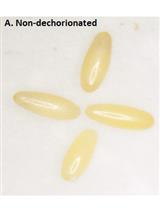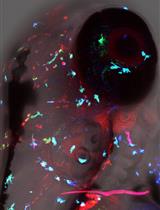- EN - English
- CN - 中文
Rearing of Culex spp. and Aedes spp. Mosquitoes
库蚊和伊蚊的饲养
发布: 2017年09月05日第7卷第17期 DOI: 10.21769/BioProtoc.2542 浏览次数: 16225
评审: Alka MehraAnonymous reviewer(s)
Abstract
Mosquito-transmitted pathogens cause major public health problems and contribute substantially to the global burden of disease. Aedes mosquitoes transmit dengue, Zika, yellow fever, and Chikungunya viruses; Culex mosquitoes transmit West Nile, Japanese encephalitis, and Saint Louis encephalitis viruses, among others. Experiments utilizing laboratory-reared colonized mosquitoes can address many issues such as vector biology, vector competence, vector-pathogen interaction, and vector control. The establishment of healthy and standardized mosquito colonies requires generation and implementation of protocols, attention to detail, and an understanding of the factors that affect mosquito fitness, such as temperature and humidity, nutrient quality and availability, population density, blood feeding and mating behavior, and egg-laying requirements. Here, we present a standard protocol for the rearing of Culex spp. and Aedes spp. mosquitoes and maintenance of the mosquito colony.
Keywords: Mosquito (蚊子)Background
Mosquitoes undergo complete metamorphosis with four life stages: egg, larva, pupa, and adult. The immature stages are always aquatic. Successful maintenance of mosquitoes in the laboratory depends on providing conditions that are optimal for each developmental stage. These requirements will vary with species, and in fact, many mosquito species, such as Cx. restuans, have not been colonized successfully in the lab. Colony maintenance is a labor-intensive process requiring time and attention to detail in handling and record keeping. When standard protocols are successful, the fitness of the mosquitoes is maintained and their suitability for repeatable experimentation is optimal. This protocol is designed for colonization and maintenance of fresh water Culex species and container-breeding Aedes species. It has been used successfully with Cx. pipiens, Cx, quinquifasciatus, Cx. tarsalis, Ae. aegypti, Ae. albopictus, Ae. triseriatus, and Ae. japonicus, among others.
Since most diseases transmitted by mosquitoes are BSL-2 and BSL-3 biological agents, experimental research with these vectors requires containment based on established guidelines (Benedict et al., 2004) as well as cooperation with institutional biosafety committees. Work with non-indigenous species also requires containment that assures no escape will occur. The Arbovirus Insectary Facility, Wadsworth Center, New York State Department of Health in Albany, NY consists of connecting arthropod BSL-2 (ABSL-2) and ABSL-3 labs. Mosquito rearing is carried out in the ABSL-2 facility under ABSL-2 guidelines. These containment guidelines are important to prevent escape of mosquitoes into the surrounding environment, preventing introduction of new species. Mosquitoes that will be infected with virus for experimental purposes are transferred into the ABSL-3 facility and handled following arthropod ABSL-3 guidelines. The mosquitoes are transferred into the ABSL-3 lab via a pass-through chamber that can be accessed from only one side at a time.
See references (Gerberg et al., 1994; Higgs and Beaty, 1996; Higgs, 2005; Imam et al., 2014) for additional information on mosquito rearing and containment.
Materials and Reagents
- Clear polystyrene cups, disposable, capacity 250 ml, height 7.5 cm, bottom diameter 5 cm, top diameter 8.5 cm (e.g., Solo, clear plastic cup, 9 oz, https://www.solocup.com/products/clear-plastic-cup/)
- Wooden applicator sticks
- Oviposition dish for Aedes spp.: black plastic dish (ramekin), approximately 10 cm width x 5 cm height (e.g., Portion cup, black plastic soufflé, WebstaurantStore Food Service and Supply, catalog number: 127P400B )
Note: The dish is half-filled with distilled water, and brown seed germination paper (Anchor Paper Company, 38-lb regular weight creped seed germination paper) or a fluted coffee filter with bottom removed is placed partially submerged around the edges. - Plastic bag
- Damp sponge
- Transfer pipets, 1 ml, polyethylene, disposable (Biologix, catalog number: 30-0135 )
- Paper towel
- Mosquito emergence jars (Mosquito Breeder) (BioQuip, catalog number: 1425 )
Note: The apparatus consists of two plastic 1-liter (L) jars that can be screwed together. Water and mosquito larvae are placed in the bottom jar, and emerging adults fly into the upper portion. A mesh hole is provided on top for respiration and food. The BioQuip breeder is equipped with a funnel between the upper and lower units, but in our insectary, better viability of the adults has been achieved by removing the funnel. - Mosquito-holding cartons, created from 0.5- or 1-L ice cream cartons or white food containers with lids (Solo, catalog number: KH16A-J8000 , https://www.solocup.com/; available also from Amazon.com). See Note 1 for details on how to modify for mosquito containers
- Fish net, 10 cm, with fine-mesh netting
- T-175 flasks (e.g., NuncTM Non-treated Flasks, Thermo Fisher Scientific, Thermo ScientificTM, catalog number: 178883 )
- Cotton coil (e.g., Fantasea 100 % Cotton Coil/12 M per Bag (FSC501), available at Amazon.com)
- Petri dish cover
- 15-ml conical centrifuge tube
- Natural hog sausage casing, available in coils of approximately 32-35 mm diameter, in brine, available at local butcher shops or on-line
Note: Store in air tight container at 4 °C for up 6 months. Do not freeze. - Gloves
- 0.22 µm Nalgene vacuum filter unit
- Tulle fabric
- Duct tape
- Gorilla glue (Gorilla Glue Company, Cincinnati, Ohio), or other polyurethane adhesive that expands slightly as it dries
- Culex spp. and Aedes spp. Mosquitoes
- Larval food: Kaytee Koi’s Choice Premium Fish Food (available at pet supply stores such as PetSmart or Petco, or at Amazon.com)
Note: Prepare by grinding in coffee grinder or blender, store in aliquots at -20 °C for up to 6 months. Another brand of koi premium fish food could be substituted. - Sugar cubes (e.g., Domino Dots sugar cubes)
- Defibrinated chicken blood for Culex rearing (100 ml, Colorado Serum, catalog number: 31143 ); defibrinated sheep blood for Aedes rearing (100 ml, Colorado Serum, catalog number: 31123 )
Note: Store at 4 °C and use within 2 weeks. - Bleach
- Ethyl alcohol 190 proof (PHARMCO-AAPER, UN1170; http://www.pharmcoaaper.com)
- Sucrose (Avantor Performance Materials, J.T. Baker®, catalog number: 4072-07 )
- 70% ethanol (see Recipes)
- 10% sucrose solution (see Recipes)
- 50% sucrose solution (see Recipes)
Equipment
- Grinder for preparation of larval food (coffee grinder or blender)
- Flask, side-arm filtering, 2 L capacity
- Mosquito cages, collapsible, aluminum frame, aluminum 20 x 20 mesh, nylon feeding hammock, access through knitted polyester stockinette sleeve; sizes 30 cm3, 46 cm3, or 60 cm3 (BioQuip, catalog number: 1450 )
- Larval flats, 35.6 cm length x 27.9 cm width x 8.3 cm height (Sterilite, catalog number: 1963 )
Note: Maximum liquid capacity 1 L to prevent spillage during transport. - Glove box, side entry, acrylic, size 30 x 24 x 24 inches (SP Scienceware - Bel-Art Products - H-B Instrument, catalog number: H50026-0000 )
- Spray bottle
- Water bath
- Freezer
- 1-L glass bottle
- Magnetic stir plate
- Dissecting microscope (e.g., Carl Zeiss, model: Stemi 2000 )
- Battery-powered aspirator (Clarke, catalog number: 13500 )
Note: It consists of a handheld ‘flashlight’ aspirator body operating off two D-cell batteries, a 16-cm length x 1.25 cm diameter inlet tube, which connects via a stopper into a collecting tube (5 cm height x 2.5 cm diameter) screened on one end.
Procedure
文章信息
版权信息
© 2017 The Authors; exclusive licensee Bio-protocol LLC.
如何引用
Kauffman, E., Payne, A., Franke, M. A., Schmid, M. A., Harris, E. and Kramer, L. D. (2017). Rearing of Culex spp. and Aedes spp. Mosquitoes. Bio-protocol 7(17): e2542. DOI: 10.21769/BioProtoc.2542.
分类
微生物学 > 微生物-宿主相互作用 > 体内实验模型 > 原生动物
您对这篇实验方法有问题吗?
在此处发布您的问题,我们将邀请本文作者来回答。同时,我们会将您的问题发布到Bio-protocol Exchange,以便寻求社区成员的帮助。
提问指南
+ 问题描述
写下详细的问题描述,包括所有有助于他人回答您问题的信息(例如实验过程、条件和相关图像等)。
Share
Bluesky
X
Copy link













